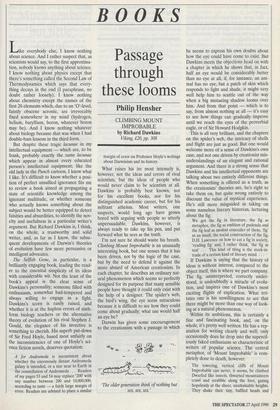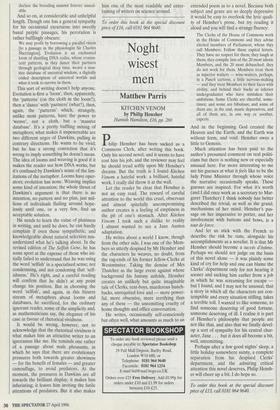BOOKS
Passage through these looms
Philip Hensher
CLIMBING MOUNT IMPROBABLE by Richard Dawkins Viking, £20, pp. 308 Like everybody else, I know nothing about science. And I rather suspect that, as scientists would say, to the first approxima- tion, nobody knows anything about science. I know nothing about physics except that there's something called the Second Law of Thermodynamics which says that every- thing decays in the end (I paraphrase, no doubt rather loosely). I know nothing about chemistry except the names of the first 20 elements which, due to an TV-level, faintly obscene acrostic, are irrevocably fixed somewhere in my mind (hydrogen, helium, baryllium, boron, whatever boron may be). And I know nothing whatever about biology because that was when I had double-bass lessons in the third form.
But despite these tragic lacunae in my intellectual equipment — which are, to be frank, probably exactly the same lacunae which appear in almost every educated person's intellectual equipment; like the old lady in the Punch cartoon, I know what I like. It's difficult to know whether a posi- tion of perfect unsullied ignorance fits me to review a book aimed at propagating a state of scientific knowledge among the ignorant multitude, or whether someone who actually knows something about the subject would be better equipped to detect falsities and absurdities, to identify the nov- elty and usefulness in a particular writer's argument. But Richard Dawkins is, I think, on the whole, a trustworthy and solid writer, and, as far as I know, the subse- quent developments of Darwin's theories of evolution have few more persuasive or intelligent advocates.
The Selfish Gene, in particular, is a brilliantly engaging book, leading the read- er to the essential simplicity of its ideas with considerable wit. Not the least of the book's appeal is the clear sense of Dawkins's personality; someone filled with enthusiasm, somewhat bad-tempered and always willing to engage in a fight. Dawkins's scorn is easily raised, and whether it is at the hapless errors of sixth- form biology teachers or the alternative theory of evolution of his rival Stephen J. Gould, the elegance of his invective is something to cherish. His superb put-down of Sir Fred Hoyle, based most unfairly on the inconsistencies of one of Hoyle's sci- ence fiction novels, deserves quotation: A for Andromeda is inconsistent about whether the enormously distant Andromeda galaxy is intended, or a star near to Earth in the constellation of Andromeda . . . Readers of my pages 53 and 54 may replace '200' with any number between 200 and 10,000,000, according to taste — a fairly large margin of error. Readers are advised to place a similar
margin of error on Professor Hoyle's writings about Darwinism and its history.
What raises his ire most intensely is, however, not the ideas and errors of rival scientists, but the ideas of people who would never claim to be scientists at all. Dawkins is probably best known, not for his excellent books, nor for his distinguished academic career, but for his militant atheism. Most writers, one suspects, would long ago have grown bored with arguing with people so utterly unpersuadable. Dawkins, however, is always ready to take up his pen, and put forward what he sees as the truth.
I'm not sure he should waste his breath. Climbing Mount Improbable is an unusually interesting book, but one senses that it has been driven, not by the logic of the case, but by the need to defend it against the more absurd of American creationists. In each chapter, he describes an ordinary nat- ural phenomenon which seems so perfectly designed for its purpose that many sensible people have thought it could only exist with the help of a designer. The spider's web, the bird's wing, the eye seem miraculous because it is difficult to see how they could come about gradually; what use would half an eye be?
Darwin has given some encouragement to the creationists with a passage in which The older generation think of nothing but sex, sex, sex.' he seems to express his own doubts about how the eye could have come to exist. But Dawkins meets the objections head on with a chapter in which he shows that, in fact, half an eye would be considerably better than no eye at all, if, for instance, an ani- mal has no eye, but a patch of skin which responds to light and shade, it might very well help him to scuttle out of the way when a big menacing shadow looms over him. And from that point — which is to say, from almost nothing at all — it's easy to see how things can gradually improve until we reach the eyes of the proverbial eagle, or of Sir Howard Hodgkin.
This is all very brilliant, and the chapters on the spider's web, the intricacy of shells and flight are just as good. But one would welcome more of a sense of Dawkins's own case, and not one driven by creationist mis- understandings of an elegant and rational argument. And there is a strong sense that Dawkins and his intellectual opponents are talking about two entirely different things. When something is offered as a truth, as the creationists' theories are, he's right to take them on, but quite wrong entirely to discount the value of mystical experience. He's still more misguided in taking on some nameless literary historian, lecturing about the fig:
We got the fig in literature, the fig as metaphor, the fig as emblem of pudenda and the fig leaf as modest concealer of them, 'fig' as an insult, the social construction of the fig, D.H. Lawrence on how to eat a fig in society, `reading fig' and, I rather think, 'the fig as text' . . . This kind of thing is the stock-in- trade of a certain kind of literary mind. . . .
If Dawkins is saying that the history of ideas is without interest, compared to the object itself, this is where we part company. The fig, uninterpreted, correctly under- stood, is undoubtedly a miracle of evolu- tion, and inspires one of Dawkins's most exciting flights of explication. What irri- tates one is his unwillingness to see that there might be more than one way of look- ing at a natural phenomenon.
Within its ambitions, this is certainly a fine and fascinating book, and, on the whole, it's pretty well written. He has a rep- utation for writing clearly and well; only occasionally does he drop into the supercil- iously faked enthusiasm so characteristic of writers of popular science. The central metaphor, of 'Mount Improbable' is com- pletely done to death, however:
The towering, vertical cliffs of Mount Improbable can never, it seems, be climbed Dwarfed like insects, thwarted mountaineers crawl and scrabble along the foot, gazing hopelessly at the sheer, unattainable heights. They shake their tiny, baffled heads and declare the brooding summit forever unseal- able.
And so on, at considerable and unhelpful length. Though one has a general sympathy for his occasional excursions into sweetly banal purple passages, his peroration is rather bafflingly obscure:
We may profit by borrowing a parallel vision [to a passage in the physiologist Sir Charles Sherrington]. Evolution is an enchanted loom of shuttling DNA codes, whose evanes- cent patterns, as they dance their partners through geological deep time, weave a mas- sive database of ancestral wisdom, a digitally coded description of ancestral worlds and what it took to survive in them.
This sort of writing doesn't help anyone. Evolution is first a 'loom', then, apparently, the 'patterns' (on the cloth in the loom?), then a 'dance' with 'partners' (what?), then, again, the 'patterns' which, strangely, unlike most patterns, have the power to `weave', not a cloth, but a 'massive database'. It's a pretty baffling mixing of metaphors; what makes it impenetrable are two different urges of Dawkins, pulling in contrary directions. He wants to be vivid; but he has a strong conviction that it's wrong to imply something he doesn't mean. The idea of looms and weaving is good if it makes the reader see how DNA works, but it's confused by Dawkins's sense of the lim- itations of the metaphor. Looms have oper- ators; evolution has none. Weaving implies some kind of intention; the whole thrust of Dawkins's argument is that there is no intention, no pattern and no plan, just mil- lions of individuals flailing around hope- lessly until one, or a very few, find an acceptable solution.
He needs to learn the value of plainness in writing, and until he does, he can hardly complain if even those sympathetic, and knowledgeable about natural selection mis- understand what he's talking about. In the revised edition of The Selfish Gene, he has some sport at the expense of those who ini- tially failed to understand that he was using the word 'selfish' in a specialised sense; not condemning, and not condoning that 'self- ishness.' He's right, and a careful reading will confirm that he didn't at any point change his position. But in choosing the word 'selfish', and again, in this bizarre stream of metaphors about looms and databases, he sacrificed, for the ordinary ignorant reader, some of the simplicity and, as mathematicians say, the elegance of his case in favour of rhetorical vividness.
It would be wrong, however, not to acknowledge that the rhetorical vividness is what makes him an attractive writer to an ignoramus like me. He reminds one rather of a passage about male pheasants, in which he says that there are evolutionary pressures both towards greater showiness — for the benefit of females — and greater camouflage, to avoid predators. At the moment, the pressures in Dawkins are all towards the brilliant display; it makes him infuriating; it leaves him inviting the futile attentions of predators. But it also makes him one of the most readable and enter- taining of writers on science around.
To order this book at the special discount price of f16, call 0181 964 9640.



























































 Previous page
Previous page